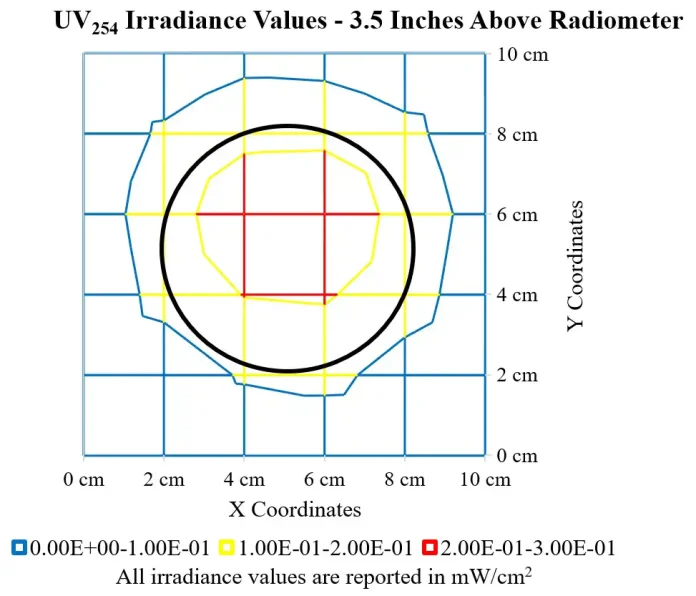
By corresponding authors Castine Bernardy, Ph.D. candidate, Civil and Environmental Engineering; and Dr. Jim Malley, University of New Hampshire
UV254 is an effective disinfection technology for drinking and wastewater applications. The COVID-19 pandemic highlighted the need to expand UV disinfection research to surface applications as another barrier for protecting public health. Surface disinfection presents its own unique challenges with regard to disinfection efficacy. The characteristics of the surface, such as pore size distribution, surface charge, hydrophilicity and contact angle all contribute to the effectiveness of UV to inactivate pathogens on a surface.
This research used a 254 nm collimated beam created by Trojan Technologies to evaluate the efficacy of UV disinfection on three surface types. The surfaces that were evaluated include aluminum, PFTE (Teflon) and ceramic, which were selected to provide a range of surface characteristics. The results of this study emphasize the importance of understanding the surface and virus interactions when utilizing UV254 as a disinfection technique.
Prior to experimentation, the average irradiance each surface would receive was determined. A 10 cm x 10 cm grid was created, and irradiance values were recorded with an IL1700 radiometer every 2 cm in the X and Y direction. Figure 1 displays the spread of irradiance emitted by the Trojan LP UV254 collimated beam and was used to determine an aerial weighted average of the irradiance.
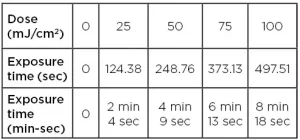
All surfaces evaluated were 6 cm in diameter, shown in Figure 1 as the black circular outline in the center of the irradiance map. All irradiance values are reported in mW/cm² and the colors in the figure corresponding to the irradiance values identified in the figure legend. The average aerial weighted irradiance inside the black circular outline was 0.203 mW/cm². This irradiance value was used to determine the exposure times necessary to achieve the desired doses for experimentation. Irradiance values were spot checked in between each disinfection experiment and remained consistent. The doses evaluated for each surface and their corresponding exposure times under the collimated beam are shown in Table 1.
The doses specified were used on the surfaces (aluminum, ceramic and PTFE) to inactivate MS-2 bacteriophage. These doses were selected based on the vast body of knowledge summarized by publications in the IUVA document library regarding MS-2 bacteriophage UV inactivation in water. The MS-2 stock solution had a concentration of approximately 5*109 PFU/mL and was transferred to the surfaces with a cotton swab. The surfaces were placed under the UV collimated beam, where they received their respective dose. The surfaces were washed with 50 mL of sterile phosphate buffer solution (PBS) using a pointed spray nozzle.
The PBS wash water was analyzed using plaque assay through collaborations with GAP EnviroMicrobial Services, Ltd. (London, Ontario, Canada) to determine viable concentrations of MS-2 bacteriophage. This process was repeated for each surface type and UV dose, producing duplicates for each experiment. Each experimental sample was split into two samples at GAP and analyzed via plaque assay for QA/QC purposes. Therefore, each UV dose resulted in four corresponding data points. The results of these experiments are displayed in Figures 2 through 5.
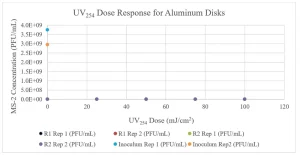
The results of these experiments are interesting in that the remaining concentration of MS-2 bacteriophage consistently is very low for all doses evaluated. The inoculum data represent the concentration of MS-2 bacteriophage added to the aluminum surface via swabbing. The figure displays the high MS-2 concentration (3*109 PFU/mL) added to the aluminum disks, compared to the concentrations recovered for each dose. Essentially no MS-2 bacteriophage was recovered during the washing procedure for any dose, including the positive control (0 mJ/cm²). The concentration of MS-2 recovered was consistent for all UV254 doses evaluated. This suggests that the dominant removal/inactivation mechanism is the aluminum surface, rather than the UV dose. The UV dose applied to the aluminum surface does not influence the remaining PFU values and corresponding log inactivation. This effect of aluminum surface on MS-2 was repeated in multiple experiments and was studied further.
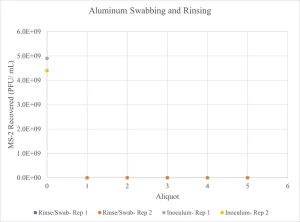
To further test the theory that viable MS-2 bacteriophage cannot be recovered off an aluminum surface, a swabbing and rinsing experiment was designed. In this experiment, one aluminum disk was inoculated with MS-2 bacteriophage via the swabbing method. The disk was rinsed with a 50 mL aliquot of sterile PBS and the surface was agitated with a clean cotton swab in an attempt to dislodge viable quantities of remaining virus. The cotton swab then was placed in the PBS wash water. This process was repeated five times in total; therefore, the disk was rinsed with a total of 250 mL of PBS and agitated with five cotton swabs (Figure 3). Each aliquot was analyzed with plaque assay, and no viable MS-2 bacteriophage was recovered. Similar to the previous figure, the data points overlap each other, indicating very low variability in the results. This experiment provides further confidence that a significant interaction occurs between the MS-2 bacteriophage virus and the aluminum surface. At this point, it is still unknown if the virus remains viable but is completely retained on the aluminum or the aluminum surface, which is known to have an aluminum oxide coating that actually causes inactivation of the virus.
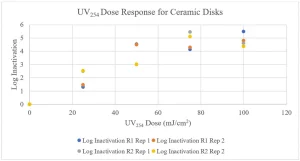
Following the aluminum experiments, ceramic surfaces were evaluated. The results of experiments using a ceramic surface (Figure 4) are quite different than the aluminum results and follow a more typical dose response curve pattern commonly seen with microbial work. The data are more scattered than the aluminum data but appear to follow an increasing trend until reaching a plateau at approximately 4.5 log inactivation, with a corresponding UV dose of 75 mJ/cm². There is a clear plateau where the log inactivation essentially remains the same at increasing doses (75 mJ/cm² and above.) The plateau likely is due to the surface characteristics (e.g., larger pore size distribution, hydrophobicity or surface charge) of the ceramic surface. Ongoing research is exploring the underlying mechanisms causing these results.
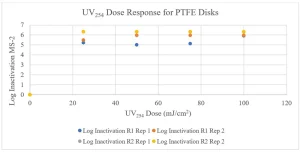
Finally, polytetrafluoroethylene (PTFE) coupons were evaluated to determine and compare their efficacy with UV254. The PTFE surface results (Figure 5) display a dose response curve much different than found with either the aluminum or the ceramic surfaces. The inactivation for this surface immediately reached a plateau at approximately 6 logs. The plateau reached is an artifact of running out of virus titer, as essentially no MS-2 bacteriophage was recovered for the 25 through 100 mJ/cm² doses evaluated. These data were interesting, as the control points, receiving 0 mJ/cm² had a very high MS-2 bacteriophage concentration remaining on the disks (5*105 PFU/mL). This suggests that the high inactivation levels observed are due to the UV doses received, unlike that of the aluminum surfaces. There likely exists an interaction between the PTFE and UV that is responsible for high inactivation levels at low UV doses. Ongoing research is exploring the underlying mechanisms that will help to explain these observed results.
The findings from this research highlight the importance of understanding the characteristics of the surface of interest. The mechanisms at play for water disinfection – such as UVT, water velocity and presence of organic matter – are not of importance for surface disinfection applications. The efficacy of UV254 as a disinfection technique varies from surface to surface and likely is a function of key surface properties, including pore size distribution and surface chemistry. Ongoing research, including the use of ddPCR techniques for virus identification and quantification, is intended to better understand the key mechanisms that explain the observed results. Understanding key mechanisms will be critical to developing better strategies for UV254 disinfection of surfaces. Elucidating mechanisms also will be a key aspect of determining whether MS-2 results are predictive of results for other viruses and may identify what properties of a virus will be important in determining its susceptibility to surface inactivation by UV254.
Additional research is being conducted on surfaces commonly used in healthcare settings, such as Formica® laminate and stainless steel. In addition, the mechanisms affecting the disinfection of each surface will be subjects of experimentation and study. With increased efforts to understand its mechanisms, the future of surface disinfection is promising.
Acknowledgements
The authors would like to thank GAP EnviroMicrobial Services, Ltd. (London, Ontario, CA) for its assistance with the viral sample analysis. In addition, they would like to thank the University of New Hampshire Civil and Environmental Engineering Department for providing the space and materials to make this research possible.
References
- Malayeri, A. M. (2016). Fluence (UV Dose) Required to Achieve Incremental Log Inactivation of Bacteria, Protozoa, Viruses and Algae. International Ultraviolet Association (IUVA)
- United States Environmental Protection Agency USEPA. (2006) Ultraviolet Disinfection Guidance Manual for the Final Long Term 2 Enhanced Surface Water Treatment Rule.
Contacts: Castine Bernardy (Castine.Bernardy@unh.edu) and Dr. Jim Malley (Jim.Malley@unh.edu)





